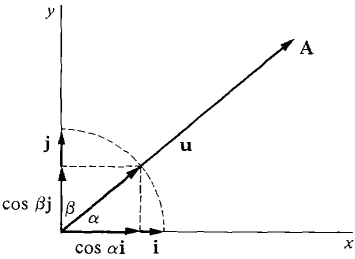| The ebook Elementary Calculus is based on material originally written by H.J. Keisler. For more information please read the copyright pages. |

|

Home  Vectors Vectors  Vector Algebra Vector Algebra  Law of Cosines Law of Cosines |
|||||||






|
|||||||
Law of Cosines
LAW OF COSINES In a triangle with sides a, b, c, and angle θ opposite side c, c2 = a2 + b2 - lab cos θ. Notice that when θ = π/2, cos θ = 0 and the Law of Cosines reduces to the familiar Theorem of Pythagoras, c2 = a2 + b2. Given vectors A and B with angle θ between them, we form a triangle with sides |A|, |B|, and |B - A|. Then by the Law of Cosines, |B - A|2 = [A|2 + |B|2 - 2|A||B| cos θ. Solving for cos θ,
The direction of a vector can be described in one of three closely related ways: by its direction angles, its direction cosines, or its unit vector. Let A be a nonzero vector. The angles α between A and i, and β between A and j, are called the direction angles of A. The cosines of these angles, cos α and cos β, are called the direction cosines of A. The vector U = A/|A| is called the unit vector of A. U has length one, |U| = |A|/|A| = 1.
Figure 10.1.22 We can see from Figure 10.1.22 that the components of U are the direction cosines of A, U = cos αi + cos βj. A vector A is determined by its length and its direction cosines, A = |A| U = |A| cos αi + |A| cos βj. The sum of the squares of the direction cosines is always one. for |U| = cos2 α + cos2 β = 1.
|
|||||||
Home  Vectors Vectors  Vector Algebra Vector Algebra  Law of Cosines Law of Cosines |
|||||||
Last Update: 2006-11-07


 Since the arccosine is always between 0 and π,
Since the arccosine is always between 0 and π,

